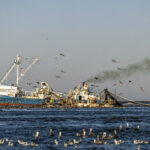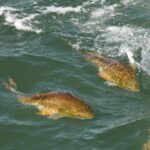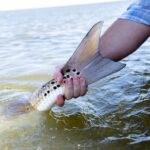
Gulf Menhaden Reduction Fishery: Bycatch Research & Useless Buffer Zones
Do you remember your driver’s test? How nervous were you when the instructor pulled out
Originally Published Here on Fissues
By Tony Friedrich
As you are probably aware, striped bass management is getting hit from all sides. The newest stock assessment will be ready in February 2019. In the meantime, some states are thinking it might be a good idea to lower the biological reference points (BRPs) for the species. In layman’s terms, BRPs are used to count how many fertile, female fish we leave in the system. If you lower the BRPs, you are saying that there doesn’t need to be so many fish left uncaught. However, we have the ability to stand up for striped bass and make sure our kids and grandchildren have the same opportunities we experienced.
There is also talk of opening the EEZ for striper harvest. Representative Zeldin’s amendment to HR 200 would do that with a small area around Block Island and open Pandora’s Box for our favorite fish. Much like pulling a thread on a sweater, it won’t take much for the striped bass management to unravel once even the smallest section of the EEZ is opened
Our record of success managing striped bass on the East Coast has been hit or miss during the last few years. In October 2014, the Striped Bass Management Board approved Addendum IV, which implemented a 25% reduction in harvest for the coastal stocks and a 20.5% reduction in harvest for the Chesapeake Bay. Coastal states used 2013 as the baseline year while the bay states used 2012. The reasoning for this was based on a 14% reduction taken by the bay states in 2013. All states had to have plans in place to meet these new goals by the beginning of the 2015 fishing season.
The management decision was in response to a notable decline in the spawning stock biomass (SSB). The 2013 Benchmark Stock Assessment showed that mortality in 2012 was well above the target and had to be adjusted to account for the increased harvest.

As you can see from the chart, there has been a steady decline in the SSB since 2006. We all hoped that Addendum IV would stem the tide because the 2011-year class. As you can see from the chart below, 2011 was an incredible year for spawning. As the decisions for reductions were handed down, we all knew that striped bass management depended on the 2011-year class making it out to the ocean and becoming part of the SSB. The year classes of 2008, 2009, 2010, 2012, and 2013, however, were well below average. This is not uncommon for striped bass spawning. Environmental conditions dictate the spawning success. We had a cool, wet spring in 2011 and that provided near perfect spawning.

Each state had the flexibility to come up with a season, creel, and size limit that would meet the reduction goals in 2014. Unfortunately, Maryland decided to increase the size from 18 inches to 20 and keep the creel limit at two fish for recreational anglers. Many of us knew this did not bode well for the 2011 fish. To combat this decision, we started a movement in Maryland in early 2015 called “My Limit is One.” It was a voluntary pledge to keep only one striper because moving the size up two inches was not going to get it done.
We had won a hard-fought victory in getting the 2015 harvest reduction. However, the devil is in the details. The 2011-year class was just getting to harvest size in Maryland. With all hopes resting on the 2011’s, did we do too little too late?
In 2012, Maryland harvested about 262,000 fish or about 1.2 million pounds. Remember, 2012 was the baseline for a 20.5% reduction. Those 2011 fish were becoming legal size, and we all knew that would be reflected in the harvest. Did we do enough in 2015 to meet the mandated reductions? Well, in 2016we harvested almost 600,00 fish and 4.3 million pounds. (I think we fell a little short). The instant reaction to this is logically, “Why isn’t Maryland being forced to reduce harvest again to meet the goals?” Well, striped bass are managed on a coast wide level. Our brothers on the coast, with the exception of New Jersey (shocking I know) all met or exceeded the reduction goals. So, when viewed as total harvest, the coastal reductions did enough to offset Maryland’s overage.
You can takeaway a couple of things from this. First, for our friends on the coast, how was your striper season so far this year? Did you see a ton of fish in the 28 to 32-inch range? As many as you would have expected knowing that 2011 was one the best spawns on record? Probably not. Why? Maryland killed way more than they should have.
It should not come as a huge surprise that Maryland is one of the states pushing the concept of lowering reference points for striped bass management. The next benchmark stock assessment is due to come out in the next few months. Since the 2011-year class did not recruit as expected, there’s a very good chance that the SSB level has dropped below the threshold, which would trigger a mandatory reduction in harvest. Rather than face that reduction, why not just lower the bar? In other words, the SSB won’t fall below the threshold if the threshold is lowered.
In addition, the recreational harvest has to be further adjusted to account for changes in MRIP, the current method for estimating recreational catch. You see, the National Academy of Sciences reviewed MRIP and found that it is chronically underestimating recreational harvest. Here’s a snapshot from the NOAA webinar showing that we harvest even more striped bass than originally thought. The blue line represents harvest after the NAS review. We are killing far more than we thought. I must be taking crazy pills because all of this points to a questionable future for the stock, but we want to hammer down and harvest more?

This is where we are. The states that did not meet their goals want to change striped bass management forever, so they can continue to harvest at unsustainable levels. This will all come to a head at the February 2019 meeting of ASMFC. It is going to take an uprising of anglers up and down the coast to stop the bay states from convincing everyone else to change the reference points. As a Maryland resident, I hope you folks up North are reading this and getting very angry. That’s what it is going to take to make sure we have abundant striped bass populations for generations to come.

Do you remember your driver’s test? How nervous were you when the instructor pulled out

If you’ve spent any time on the water in South Florida, chances are you’ve heard

Photo Credit: Graham Tayloe Big Win for Redfish in Alabama Huge news from the Marine

Feature Photo: Carter Abramson | Simms Fishing at the Fisheries Science Symposium We have more
We rely on our members and donations to keep fighting for a sustainable tomorrow in marine conservation.
GIVE THE GIFT OF FISHERIES CONSERVATION THIS HOLIDAY SEASON. SHOP ASGA GOODS THAT FUND FISHERIES RESEARCH & ADVOCACY CAMPAIGNS
JOIN ASGA IN CALLING FOR CRITICAL MANAGEMENT ACTION AFTER YEARS OF SPAWN FAILURES & POOR MANAGEMENT.
By using this website, you agree to our use of cookies. We use cookies to provide you with a great experience and to help our website run effectively. To learn more, please review our privacy policy.